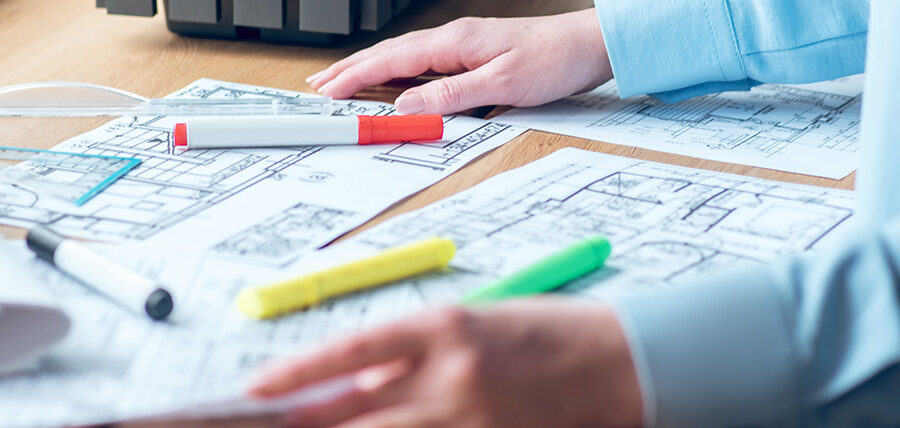
The Nuances of Retail Store Planning & Construction
With ASG Experts Elizabeth Seitz + Jennifer Crawford
Ask ASG’s Elizabeth Seitz to describe what store planning and construction is like these days and she will tell you, “It’s kind of like horse racing, but with bulldogs who all scatter and move around. We veer between lanes to make the shortest and best path.” she says. “We all start off in our own lanes, but if you really want to be efficient, you must cross lanes and work together to get to the finish line.”
Seitz, ASG partner, construction, says working in store planning and construction is ever-changing, and to succeed, you must be adaptable. With over a century worth of combined experience, our Store Planning and Construction team has been navigating the rough industry waters for quite some time. We sat down with Seitz as well as Senior Project Manager Jennifer Crawford about the years they’ve spent becoming masters of the trade and what the current landscape for retail planning and construction looks like.
Q: What led you to a career in store planning and construction?
Elizabeth: I went to school for interior design and the first several years were the same as an architecture student. They wanted me to transfer to architecture after getting good grades in structures/environmental sciences, but I didn’t want to only stamp drawings. That’s how I ended up in design where I got my first internships— at RTKL, Genzler, and I. Magnin stores— which paved my way into retail design.
I found that I was evolving by being in in-house retail design, where you tend to do a little bit of everything from procurement to construction. I was very involved through the whole process of my projects, from concept through execution.
Jennifer: When I was little, I was always rearranging my bedroom every month; I was always into interior design. Over the summers, instead of getting a job, I’d redo the basement, build a deck, and take on other home improvement projects around my family’s home.
After high school, I went to The Ohio State University for interior design to get both an architecture and an interior design education. I ended up falling in love with interior design. I did one internship during school at The Limited. Post-grad, I started working at an architecture firm, and then to dELiA*s to do store design and construction (SD&C). I came over to ASG when dELiA*s decided to outsource their SD&C functions because they were already handling their real estate and I’ve been here for 12 years!
“Store Planning + Construction is all about being reactive all the time and twisting that into being proactive to get ahead of the game. You always want to make sure to keep the horse in front of the cart, even when it gets reversed.” -Elizabeth Seitz
Q: What are the challenges in planning and constructing retail stores?
Jennifer: Right now it’s permitting and construction manpower. Permitting changes from city to city, and the requirements are different every time. Everyone everywhere is facing understaffing, which can really clog things up in a project. There’s nothing you can do about either of those things, except to completely adapt, pull it together, and get things done as timely as possible. Adapting to all the different client programs and how they do things differently is a big hurdle as well, but a lot of the time they’re coming to us because of our knowledge to listen and partner with us.
Q: Is it always the same process between projects?
Elizabeth: There is a good general overarching process you need to know that you can carry between projects, and by knowing the overall process you can tweak the steps. It’s like planning a wedding— it’s all the same whether there are 5 or 500 guests. You can start to tweak based on the goal volume of stores to be built. At a wedding, you can go more over the top if you have 5 people vs. 500, but it’s kind of the opposite when designing stores.
When a smaller volume of stores needs to be designed, it typically comes with a smaller budget than a huge rollout program. You must think logically and use your partners to pivot intentionally. If you can partner better, then you can work faster and cut time out of the schedule to take shortcuts and save resources.
Q: What are the biggest differences when working on a prototype design, as opposed to a roll-out program?
Elizabeth: Budget. budget. budget. The prototype is a different budget than the roll-out program. Revealing the brand image is the key focus when building a prototype all while knowing that when you go to volume, you’ll need to bring the original budget down to make it scalable.
Timing and schedules can’t be forgotten either. Prototypes are always bumpier— you’re in discovery mode regarding brand image. You always have multiple meetings with the client’s brand team to take inventory of what’s working. Once you get into rollout it’s a whole different group of levers you have to push and pull. It becomes all about timing: permitting time, scheduling time, and the number of stores they want to open that year so that they meet their sales goals and projections.
The prototype is where you really get to be explorative to the point where you’re looking at a million different options. In rollout, you home in to get the best price and best quality of materials. I try to use value engineer finishes— it’s just a look! The custom finishes do not always hold up nor have longevity. I love working different angles of the custom, brand-ownable layers to bring down costs with vendors and installations because as we all know, time is money.
Q: What is the most rewarding aspect of working in this field?
Elizabeth: Retail is fast-paced and that means you get to design a store, and within the year, it comes to life. You get a strong sense of accomplishment in being a part of the entire process— from dealmaking through opening the doors for sales. Planning and construction require expert-level problem-solving. Planning is like a giant game of Jenga; we make sure everything is perfectly coordinated and fits. It’s a fun challenge to think about building in any type of environment—an external street location, interior mall location, you name it. How do you translate the brand and execute that brand in multiple different avenues?
The other fun thing is that by the time it gets to us, the design concept is figured out; we’re just executing. When it gets into construction and planning, it’s all around the timeline. Get documents, permit, landlord approval, then construction. It’s a finite time we have based off possession date and rent commencement.
Inevitably something will always go wrong. You always must plan for that “oh sh*t!” moment. Having the ability to pivot quickly and bring in partners to solve issues in the moment provides a sense of accomplishment without delay.
Jennifer: I have a passion for value engineering. I’m cheap at heart, so I’m always eager to see what we can do to make things work better for less cost. There are tons of other options that will work just as great as the original that your everyday retail customer will never notice the difference. I love finding the needle in the haystack that fits the solution perfectly.
Q: What is your favorite project you’ve completed over the years?
Jennifer: Tonal 5th Avenue because it was a flagship. It was a fun challenge—a flagship on a budget. Your typical flagship in NYC is going to be millions, but I think we were at $500k at the end of the day here and it turned out amazing. It was super fast too! Our first time looking at the space was at the end of March, and it was finished by Labor Day. Collaborating with their small team— with one creative director— really gave us the opportunity to get into the details and work seamlessly together. We were able to interpret and implement everything from infinity mirrors, edge-lit backlit panels, etc all while reusing the shell as much as possible.

Q: What advice do you have for brands looking to build their stores and go into brick-and-mortar right now?
Elizabeth: Be thoughtful and planful. When it comes to store planning and construction, think about it not only from space planning but also brand image and store operational perspectives. In theory I can build anything or make anything work, if you give me the time and the money, but that doesn’t always work with the brand and their business projections. If it takes 1.5 weeks to build vs. 2 days, there’s materials and costs you can save. Often operations are not thought of until customers and employees enter the space.
Jennifer: Don’t go too quickly. Take it slow. You don’t need to go from 0 to 20 stores in a year—especially if you’re just starting out. You don’t have to commit to rolling something out across the entire fleet. Give yourself the chance to evaluate what works and what doesn’t. How does it work for the staff? Customers? What if we can’t duplicate it? Or if you must change it for every single store? Someone needs to be the keeper of the standards and organization, and that’s where we step in.


